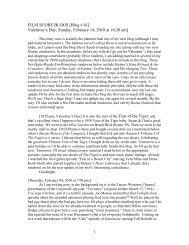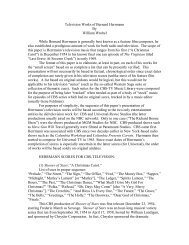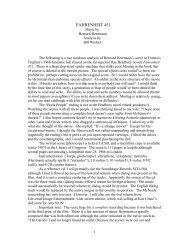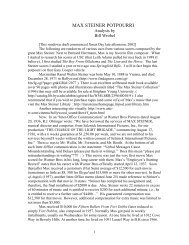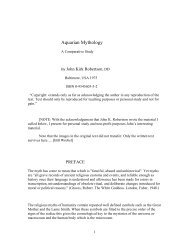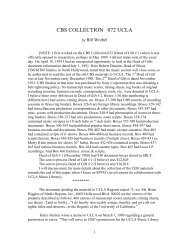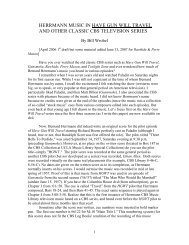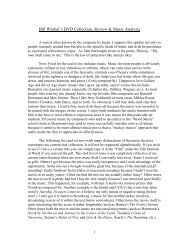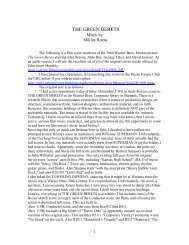TEMPO MARKINGS OF BERNARD HERRMANN SCORES ...
TEMPO MARKINGS OF BERNARD HERRMANN SCORES ...
TEMPO MARKINGS OF BERNARD HERRMANN SCORES ...
You also want an ePaper? Increase the reach of your titles
YUMPU automatically turns print PDFs into web optimized ePapers that Google loves.
Steiner tended to focus upon). Since Herrmann’s style was fundamentally mood music,<br />
elaborated tempo markings would be important in designating the proper character of the<br />
piece. As given earlier, metronome markings were quite secondary to Herrmann.<br />
Herrmann predominantly used traditional Italian terminology (lingo). He also<br />
occasionally used English terms, especially Slow (almost never Fast) and Slowly. For<br />
some reason, he especially used them for his Crime Classics cues, while he would rarely<br />
use Lento for the crime Classics. I believe the only French term was Lent (slow). He did<br />
not use German words for tempo markings, although he did for some instruments<br />
(customarily Pos for trombones, and Fags for bassoons). As a modifier meaning “very,<br />
Herrmann used assai such as Lento assai (very slow or quite slow) in the “Scene<br />
d’amour” cue of Vertigo. Interestingly, he would also use the modifier assi that I assume<br />
is a synonym for assai (but I cannot verify this). In fact, the use of assi is not normally<br />
listed in any of the standard books on tempo marking. I know that Liszt used, say, Lento<br />
assi in some of his piano works e.g., Piano Sonata in B minor). Herrmann used that for<br />
“The Mushroom Forest” cue in Journey To the Center of the Earth. Tchaikovsky used<br />
Moderato Assi in his third symphony. Herrmann used it for “The Grotto” cue in Journey<br />
To the Center of the Earth. Howard Hanson used Allegro Assi in his Sixth Symphony (I<br />
did not find an Allegro Assi in Herrmann’s works so far, nor even Allergo Assai). So I<br />
believe Herrmann saw these unusual tempo markings from other composers that he<br />
studied and perhaps conducted, and utilized them occasionally in his own works.<br />
Some colorful tempo markings are seen only once or twice in Herrmann cues. For<br />
instance, Allegro con Fuoco (fast with fire) is used in Bar 13 of “The Ridge” cue of<br />
Garden of Evil. Many composers used this particular tempo marking, including<br />
Tchaikovsky, Dvorak, Chopin, and so forth. You can put “Allegro con Fuoco” in Google<br />
to search exact titles. Allegro con Brio (fast with spirit) is used more often. The “Fire<br />
Engine” cue from Fahrenheit 451 used this, although I believe it would’ve been<br />
humorous and clever if Herrmann instead used Allegro con Fuoco under the<br />
circumstances! : )<br />
Now: If you put Herrmann’s metronome markings to the reality test (in my case,<br />
comparing them to a downloaded and Winzip executed v 1.5 metronome from Music-<br />
Theory.com), you will find that they are not particularly reliable. I think that Herrmann<br />
often just habitually put generalized numbers on many cues (especially television works).<br />
There are many instances where his marking is pretty dead on as well. Examples of<br />
correct metronome markings include:<br />
-“The Genie’s Home” (Molto Tranquillo) from Sinbad in C time. Quarter note = 60.<br />
-“Prelude” (Allegro Molto Pesante) from Sisters in C time. Quarter note = 120.<br />
-“The Cobra Dance” from Sinbad in C time (Allegro). Quarter note = 120.<br />
-“The Chariot Ride” (Vivo) from Egyptian in Cut time. Half note = 120.<br />
Incidentally, the Morgan/Stromberg version on Marco Polo was even faster at<br />
about 130 b.p.m.<br />
A sample of unreliable metronome markings written in by Herrmann:<br />
CUE Herrmann’s M.M Metronome<br />
“Space Stations” (Outer Space Suite) C time Quarter = 80 Quarter = 106<br />
“Danger” (Outer Space Suite) Allegro Mod. In C Quarter = 100 Quarter = 128<br />
“Signals” (Outer Space Suite) Presto in C time Quarter = 180 Quarter = 152<br />
“The House” (North by NW) Moderato in 3/8 Quarter = 60 Quarter = 76<br />
5




